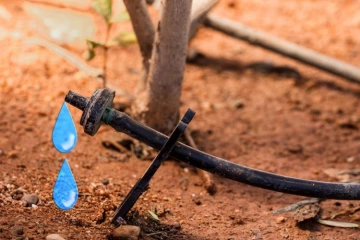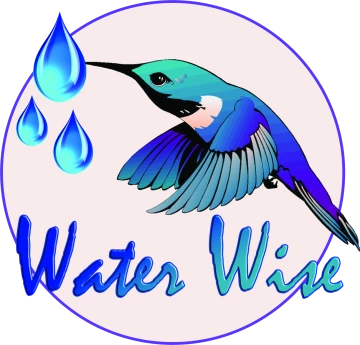
There are a number of water-efficient irrigation systems for your garden and landscapes.
Drip Irrigation
Drip Irrigation is a system of plastic tubing that delivers water to a plant landscape. It's an efficient way to water your outdoor landscapes that reduces over-watering and reduces your water bills.
- It is designed to slowly deliver water to the plant's root system allowing the water to soak in rather than run off or be evaporated by wind or sun. The specific delivery of drip makes it an efficient way to water landscapes- if managed properly.
- Good systems will have different valves or stations for the different water needs of plant. Trees, shrubs, bedding plants and turf all had different water needs.
- Trees roots are found in the top 3 feet of soil. Each time a tree is watered, the water should soak from the top of the soil to a depth of 3 feet. Shrub roots are about 2 feet deep, and bedding plants and turf roots are about 1 foot deep. So you don't over or under-water your plants - remember it's as easy as 1-2-3.
- How deep water penetrates can easily be determined by using a soil probe. This is a a thin metal rod (3/8 in. or so) about 2'-3' long. Irrigation turn-key's can be modified into soil probes by cutting of the "u" at the end. Insert the probe into the ground after about an hour after watering. It will stop when it reaches dry soil. If a rock is hit, try another place. Look at the end of the rod and check for moisture. When the rod won't penetrate the soil more than 4 in., then it is time to irrigate deeply again.
- Deliver water at the drip line of a plant. This is the area directly underneath the outer tip of the branches. This is where roots can best absorb water. When it rains, the foliage of the plant keeps water from landing underneath it, but drips water off the ends of the branches for the tips of the roots to absorb.
- Expand your irrigation emitters as your plant grows. Once you become familiar with your system and how your plants use water, then you can determine watering schedules for the four seasons and program them into the controller. Enormous waste occurs in neglected irrigation systems.
- Broken lines, misplaced emitters, poorly designed systems all add up. When an irrigation system is installed, a plan should be made and kept with house papers for referral- for you and future owners. Use the plan to check emitter placement, output, and general maintenance at least once a year.
Micro-Basin Flooding
- With this method of irrigation, berms are used to contain water delivered at a faster rate than drip. A single bubbler is put near the base of the plant or series of plants, and the entire root system is flooded.
- Berms need to be expanded as the plant's dripline expands. When bubblers are designed into a system, they should always be the method of irrigation as the plant roots grow to absorb water delivered in that way.
- Bubblers should be placed far enough away from the base of the plant as to not promote root rot from contact with wet soil.
- Use the soil probe method for determining how long to run your system for optimum water use.
- Keep in mind that water has weight. As weight is put on soil, and the soil becomes compacted, less pore space is available for water, and the soil may not be able to absorb as much water as it used to. This is a disadvantage to basin-flooding as a watering method.
Soaker Hoses
These hoses are black porous hoses generally made out of recycled rubber. When screwed onto a regular hose, the soakers "weep" and deliver water at a slow rate. Soaker hoses can be used to temporarily water desert zone plants if the season has been particularly dry, or be put in flower beds. Cover them with mulch and they can be left unnoticed. Hand - Held Hoses/Manual Sprinklers: Outdoor faucets can flow as much as 5 gallons a minute or 300 gallons per hour. Often sprinklers and hoses deliver water at a much faster rate than the soil can absorb. Excess water often runs-off and doesn't have a chance to soak into the soil, potentially wasting a lot of water.
Irrigation Brochures
The Lawn Watering Guide for Cochise County guides you through doing a sprinkler output test and provides a watering schedule for cool season, warm season, and overseeded grasses.


